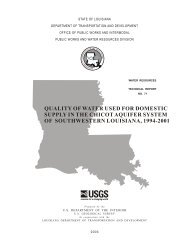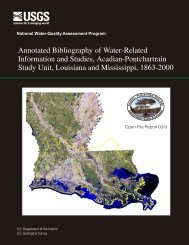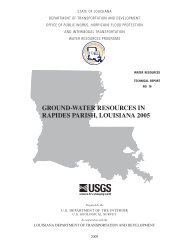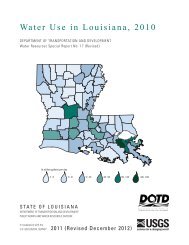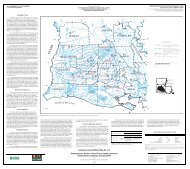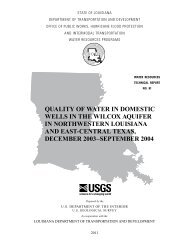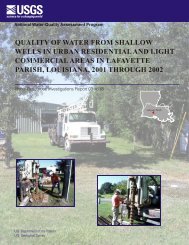environmental setting, water quality, and ecological indicators of
environmental setting, water quality, and ecological indicators of
environmental setting, water quality, and ecological indicators of
Create successful ePaper yourself
Turn your PDF publications into a flip-book with our unique Google optimized e-Paper software.
<strong>and</strong> manganese were exceeded in surface <strong>water</strong>. Concentrations<br />
<strong>of</strong> nutrients <strong>and</strong> major inorganic ions in<br />
ground <strong>water</strong> <strong>and</strong> surface <strong>water</strong> generally were largest in<br />
the southeastern part <strong>of</strong> the study area. In ground <strong>water</strong>,<br />
concentrations <strong>of</strong> 16 pesticides <strong>and</strong> degradation products<br />
were detected but did not exceed MCL’s, HA’s, or<br />
aquatic-life criteria. In surface <strong>water</strong>, 59 pesticides <strong>and</strong><br />
degradation products were detected. Concentrations <strong>of</strong><br />
three pesticides exceeded criteria for the protection <strong>of</strong><br />
drinking <strong>water</strong> or aquatic life, <strong>and</strong> peak concentrations <strong>of</strong><br />
one pesticide exceeded numeric targets for TMDL’s.<br />
Nutrients<br />
Nitrogen <strong>and</strong> phosphorus are nutrients <strong>of</strong> particular<br />
importance because they are necessary for the proper<br />
growth <strong>and</strong> development <strong>of</strong> plants, but can cause the<br />
eutrophication <strong>of</strong> lakes, streams, <strong>and</strong> rivers, <strong>and</strong> at high<br />
levels may adversely affect human health. Eutrophication<br />
is the enrichment <strong>of</strong> a <strong>water</strong> body with nutrients that<br />
can occur naturally, but most <strong>of</strong>ten results from discharge<br />
<strong>of</strong> waste<strong>water</strong> effluent, or run<strong>of</strong>f from agricultural areas.<br />
Streams enriched with nutrients might be subject to<br />
excessive plant growth resulting in algal blooms <strong>and</strong><br />
propagation <strong>of</strong> invasive aquatic plants, such as <strong>water</strong>hyacinth<br />
<strong>and</strong> hydrilla, that contribute to recreational<br />
impairment <strong>and</strong> adverse effects on aquatic life. The<br />
USEPA (2002b) has identified Bayou Nezpique, Bayou<br />
Mallet, <strong>and</strong> Bayou des Cannes as impaired by nutrients,<br />
<strong>and</strong> Bayou Plaquemine Brule, Bayou Queue de Tortue,<br />
Bayou Lacassine, <strong>and</strong> the Mermentau River as impaired<br />
specifically by nitrogen. The USEPA (2002b) established<br />
an MCL <strong>of</strong> 10 mg/L for nitrate as nitrogen in<br />
drinking <strong>water</strong> because concentrations greater than this<br />
increase the risks <strong>of</strong> methemoglobinemia (blue-baby<br />
syndrome) (Hem, 1992). Nitrogen concentrations determined<br />
for this study include ammonia; dissolved <strong>and</strong><br />
total ammonia plus organic nitrogen; nitrite; <strong>and</strong> nitrite<br />
plus nitrate as nitrogen. Minimum, median, <strong>and</strong> maximum<br />
concentrations <strong>of</strong> nitrogen are shown in table 4.<br />
Maximum concentrations <strong>of</strong> nutrients in surface <strong>water</strong><br />
occurred at sites with high agricultural intensity between<br />
February <strong>and</strong> July.<br />
Ammonium is the recommended form <strong>of</strong> nitrogen<br />
used to fertilize rice because nitrate is reduced to nitrous<br />
oxide <strong>and</strong> nitrogen gas in flooded rice fields. The highest<br />
concentrations <strong>of</strong> dissolved ammonia <strong>and</strong> dissolved<br />
ammonia plus organic nitrogen in ground <strong>and</strong> surface<br />
<strong>water</strong> occurred in the southeastern part <strong>of</strong> the study area.<br />
Although the median concentration <strong>of</strong> dissolved ammonia<br />
in surface <strong>water</strong> (0.11 mg/L) was more than three<br />
times the median concentration in ground <strong>water</strong><br />
(0.032 mg/L) (table 4), the maximum concentration<br />
occurred in ground <strong>water</strong> (2.56 mg/L at well 41)<br />
18<br />
(table 5). The maximum concentration in surface <strong>water</strong><br />
(1.65 mg/L) occurred at Theriot (table 5), a site with high<br />
agricultural intensity. The median concentration <strong>of</strong> dissolved<br />
ammonia plus organic nitrogen in surface <strong>water</strong><br />
(0.86 mg/L) was more than eight times the median concentration<br />
in ground <strong>water</strong> (less than 0.10 mg/L). Concentrations<br />
<strong>of</strong> dissolved ammonia greater than 0.50 mg/L<br />
<strong>and</strong> concentrations <strong>of</strong> ammonia plus organic nitrogen<br />
greater than 2.0 mg/L occurred at surface-<strong>water</strong> sites that<br />
drained areas with high agricultural intensity. The maximum<br />
concentration <strong>of</strong> dissolved ammonia plus organic<br />
nitrogen occurred in surface <strong>water</strong> (4.0 mg/L at Theriot);<br />
the maximum concentration in ground <strong>water</strong> (2.7 mg/L)<br />
occurred at well 41. Concentrations <strong>of</strong> total ammonia<br />
plus organic nitrogen were determined for surface-<strong>water</strong><br />
samples only (table 4); the median concentration was<br />
1.3 mg/L <strong>and</strong> the highest concentration (5.1 mg/L)<br />
occurred at Mermentau, a site with high agricultural<br />
intensity.<br />
The median concentration <strong>of</strong> nitrite plus nitrate<br />
(nitrate) was higher in surface <strong>water</strong> (0.230 mg/L) than<br />
in ground <strong>water</strong> (less than 0.050 mg/L), but the highest<br />
concentration (12.6 mg/L) occurred in ground <strong>water</strong><br />
(fig. 8) at well 22. Concentrations greater than<br />
1.00 mg/L occurred at three sites (Des Cannes, Iota, <strong>and</strong><br />
Plaquemine) with high agricultural intensity; however,<br />
the maximum concentration in surface <strong>water</strong><br />
(3.03 mg/L) occurred at the Church Point site, a site with<br />
low agricultural intensity. The peak nitrate concentrations<br />
at Church Point may have been caused by livestock<br />
(fig. 9) <strong>and</strong> at the other three sites by fertilizer applications<br />
in fall <strong>and</strong> spring (fig. 10). The nitrate concentration<br />
at well 22 (12.6 mg/L) was the only exceedance <strong>of</strong><br />
the USEPA (2000a) MCL for nitrate (10 mg/L) in<br />
ground- or surface-<strong>water</strong> samples. This well is shallow<br />
(30 ft), <strong>and</strong> l<strong>and</strong> around the well was used previously for<br />
poultry <strong>and</strong> swine production. Leaching <strong>of</strong> animal waste<br />
may account for the nitrate concentration in the well.<br />
Nutrients from ground <strong>water</strong> used for agricultural<br />
irrigation do not contribute significantly to eutrophication<br />
in surface <strong>water</strong>. Concentrations <strong>of</strong> nitrogen <strong>and</strong><br />
phosphorus in samples from ground <strong>water</strong> generally<br />
were below the thresholds for total nitrogen (1.50 mg/L)<br />
<strong>and</strong> total phosphorus (0.075 mg/L) indicating eutrophic<br />
potential (Dodds <strong>and</strong> others, 1998), whereas concentrations<br />
in samples from surface <strong>water</strong> generally exceeded<br />
the thresholds. In ground <strong>water</strong>, the median concentration<br />
<strong>of</strong> total dissolved nitrogen (the sum <strong>of</strong> dissolved<br />
ammonia plus organic nitrogen <strong>and</strong> nitrite plus nitrate)<br />
was less than the sum <strong>of</strong> detection limits (0.15 mg/L)<br />
(table 4), <strong>and</strong> the median concentration <strong>of</strong> dissolved<br />
phosphorus was 0.07 mg/L (table 6). In surface <strong>water</strong>,



